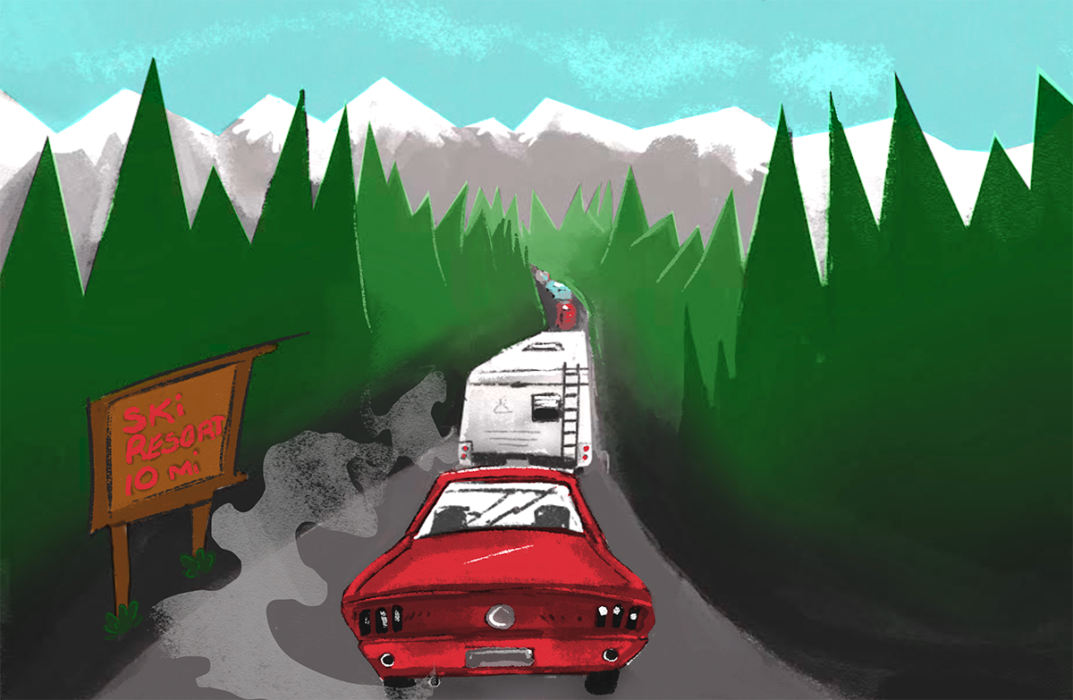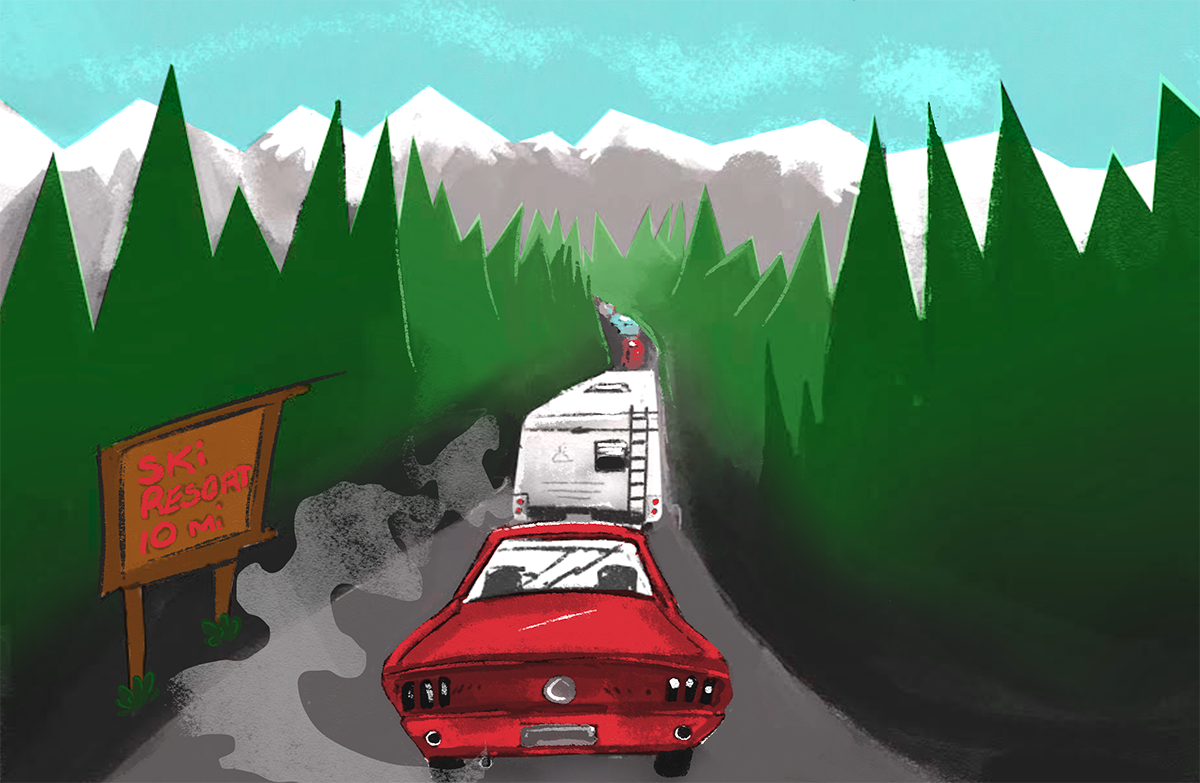
On January 4, I tried to go skiing. The 70-mile drive from my home in Tacoma to the Crystal Mountain ski area usually takes a little under two hours. But on that day, when my friend and I hit Enumclaw, the last major town (population: 11,000) before the ski hill, traffic was already backed up with some 40 miles to go. We stopped for lunch, went for a short hike, and eventually got to the ski hill six hours after we departed that morning. Upon arrival, we were told: No parking. Turn around.
A week later, I didn’t take any chances — I drove up Friday and stayed overnight. The following morning, the parking lot was full by 7:45 a.m. Folks I spoke with on the chairlifts left home at obscenely early hours to beat the traffic. “It can be fun when you get a group of friends and some coffee,” one woman, who left Seattle at 4:30 a.m., told me. Around noon, cars were backed up for miles on the highway. Shuttle buses were being escorted around the stuck cars, forcing oncoming traffic to drive on the shoulder of the two-lane route.
Crystal Mountain’s traffic woes were temporarily acute — those weekends offered the first big snowfalls of the season, and other mountain passes were closed — but they nonetheless embody a regional trend that’s unlikely to fix itself. “We are seeing a lot of these small rural communities … experiencing big-city issues,” said Danya Rumore, an associate professor at the University of Utah who studies recreation hotspots around the West. A common one, she said, is “transportation issues that you just don’t expect to see in a rural area.” But when small towns face urban issues, they can also turn to urban solutions.
Want to support independent Western journalism?
Consider a Bitterroot sponsorship for your company or organization.
Transit agencies in cities such as Seattle, Portland, and San Francisco shuttle residents to popular trailheads, and buses can help manage crowds in much smaller burgs. Last week, for instance, some 120,000 Sundance Film Festival attendees descended on Park City, a resort town in the Wasatch Mountains with 8,500 full-time residents. Park City feels a traffic pinch during Sundance, sure, but folks are able to move around in part because of a relatively robust transit system — a free one, to boot.
Park City’s fare-free buses started as a small community program in the 1970s, said Alfred Knotts, the city’s transportation director. But as the former silver mining town grew into a tourist destination — it has two enormous, top-tier ski resorts — the buses, funded by a combination of local, state, and federal money, became an integral piece of the transportation infrastructure. According to Knotts, about 5 percent of local vehicle trips there are taken via transit — double the national average, and on par with some much larger cities. On-board surveys found that ridership consists primarily of local workers earning less than $25,000 a year and visitors whose incomes top $100,000. Park City buses shuttled about 2.8 million passenger trips last year; during Sundance, they’ll move 30,000 people a day.
“It’s an amenity to Park City, and gives us a competitive advantage over other resort towns,” Knotts said.
Most Western ski towns don’t have a decades-old bus system to retool, however. Helping communities that are starting from scratch is Rumore’s specialty. She runs the University of Utah’s Environmental Dispute Resolution Program, which consults with small Western communities as they navigate growth and tourism pressure.
Since 2016, her program has been active in the Zion National Park region. Thanks in part to the state’s aggressive marketing, more than 4 million tourists choke the rural roads near Zion each year. Springdale, the town closest to the park’s entrance, is home to about 600 people, but can see 10,000 visitors a day drive through.
Rumore’s team brought together stakeholders from the National Park Service, area towns and counties, the state of Utah, and other groups to consider a transportation system that both keeps tourists moving and protects the area’s character. The group came up with a transportation wish list and is now working to enact that vision. The state is spending $15 million to plan transit service between St. George, the area’s largest city, and Springdale, where visitors can catch a shuttle into the national park. A path designed with e-bikes in mind is being considered, as well.
Rumore said the negotiations taking place in the Zion area could serve as a model because they are taking a regional approach that factors in each community’s desires. The bus system, for instance, could help St. George boost its reputation as a tourism destination while easing transportation through Springdale, whose small-town residents don’t want as much hubbub.
“It’s not kumbaya, let’s all get along,” Rumore said. “Collaboration is about interested negotiation, and figuring out solutions that work well for all parties.”
Back in Washington, Crystal Mountain’s issues are compounded by its proximity to the Seattle metro area. Many have blamed its traffic woes on the ramped-up marketing around relatively low-cost Ikon season passes, which the resort’s owner, Alterra, began offering last year. But the Seattle-Tacoma area added half a million residents in the last decade, many of whom relocated for high-paying jobs that can fund a trip to the ski hill.
“There are a lot more of us charged up to play in the powder,” Frank DeBerry, Crystal’s chief operating officer, said in an open letter to customers regarding the overcrowded weekends. “Our region too is bursting with a lot more folks who live here because of what our mountains offer. Crystal has not been immune and we’re all feeling the crush.” Crystal representatives didn’t respond to multiple requests for comment.
The resort offers bus service from Seattle, Tacoma, and Enumclaw, but tickets range from $20 to $40. It also ended walk-up lift ticket sales on weekends, at least for now; visitors must purchase them in advance online. But Knotts, of Park City, said Crystal ought consider a tactic being utilized by more and more ski resorts. “The first thing I’d do is charge for parking,” he said. Utah’s Solitude Mountain — another Alterra resort — this year became the first in the state to do so. Jackson, Wyoming, utilizes the same tactic: a $30 resort parking fee could compel skiers to take the $3 bus from town instead.
Enumclaw Mayor Jan Molinaro, for his part, is happy to see the uptick in traffic. “We’re embracing it,” he said. “We’re looking to add to our tourism, whether it’s winter or summer traffic.” To better maximize the potential of nearby amenities like Crystal and Mount Rainier National Park, officials aim to increase the number of hotels and short-term rentals in town. “People come through Enumclaw, whether they stop or not, to visit the mountain, to ski, to hike,” he said. The goal is to get them to stop more often.
Traffic up to Crystal Mountain has eased up with more consistent snowfall and the end of walk-up ticket sales, but Molinaro is under no illusion that slowdowns won’t happen again. He met with DeBerry before the season to discuss park-and-ride options in Enumclaw and another town nearby, and thinks all parties need to be proactive about transportation in coming years. “Additional transportation, or some transportation plan in coordination, should still be looked at,” he said.
Such discussions, Rumore said, are an important first step. Whether it’s a town, a ski resort, or a national park, “none of these entities can solve it alone. And if you kick the can down the road, you create problems for other entities.”

